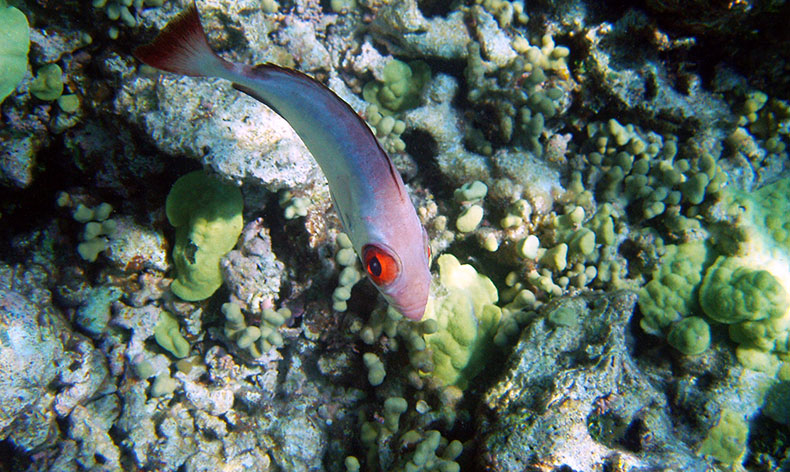
Developing the Report
The process for preparing condition reports involves a combination of accepted techniques for collecting and interpreting information gathered from subject matter experts. The approach varies somewhat from sanctuary to sanctuary, in order to accommodate differing styles for working with partners. The Papahānaumokuākea Marine National Monument approach was closely related to the Delphi Method, a technique designed to organize group communication among a panel of geographically dispersed experts by using questionnaires, ultimately facilitating the formation of a group judgment. This method can be applied when it is necessary for decision-makers to combine the testimony of a group of experts, whether in the form of facts or informed opinion, or both, into a single useful statement.
The Delphi Method relies on repeated interactions with experts who respond to questions with a limited number of choices to arrive at the best supported answers. Feedback to the experts allows them to refine their views, gradually moving the group toward the most agreeable judgment. For condition reports, the Office of National Marine Sanctuaries uses 17 questions related to the status and trends of monument resources, with accompanying descriptions and five possible choices that describe resource condition.
In order to address the 17 questions, monument staff selected and consulted outside experts familiar with water quality, living resources, habitat, and maritime archaeological resources. A small workshop (around 10-20 participants) was convened where experts participated in facilitated discussions about each of the 17 questions. Experts represented various affiliations including Clancy Environmental Consultants, Hawai'i Department of Land and Natural Resources, Hawai'i Institute of Marine Biology, NOAA's Office of National Marine Sanctuaries, NOAA's Pacific Islands Fisheries Science Center, and the U.S. Fish and Wildlife Service. At the workshop each expert was introduced to the questions, was then asked to provide recommendations and supporting arguments, and the group supplemented the input with further discussion. In order to ensure consistency with Delphic methods, a critical role of the facilitator was to minimize dominance of the discussion by a single individual or opinion (which often leads to "follow the leader" tendencies in group meetings) and to encourage the expression of honest differences of opinion. As discussions progressed, the group converged in their opinion of the rating that most accurately describes the current resource condition. After an appropriate amount of time, the facilitator asked whether the group could agree on a rating for the question, as defined by specific language linked to each rating (see Appendix A). If an agreement was reached, the result was recorded and the group moved on to consider the trend in the same manner. If agreement was not reached, the facilitator instructed monument staff to consider all input and decide on a rating and trend at a future time, and to send their ratings back to workshop participants for individual comment.
The ratings and text found in the report are intended to summarize the opinions and uncertainty expressed by the experts, who based their input on knowledge and perceptions of local conditions. Comments and citations received from the experts were included, as appropriate, in text supporting the ratings.
The first draft of the document was sent back to the subject experts for what was called an Initial Review, a 21-day period that allows them to ensure that the report accurately reflected their input, identify information gaps, provide comments or suggest revisions to the ratings and text. Upon receiving those comments, the writing team revised the text and ratings as they deemed appropriate. The final interpretation, ratings, and text in the draft condition report were the responsibility of monument staff, with final approval by the monument manager. To emphasize this important point, authorship of the report is attributed to the monument alone. Subject experts were not authors, though their efforts and affiliations are acknowledged in the report.
The second phase of review, called Invited Review, involved particularly important partners in research and resource management, including NOAA's Marine Debris Program and NOAA's National Marine Fisheries Service. These bodies were asked to review the technical merits of resource ratings and accompanying text, as well as to point out any omissions or factual errors. The comments and recommendations of invited reviewers were received, considered by sanctuary staff, and incorporated, as appropriate, into a final draft document.
A draft final report was then sent to Dr. Jo-Ann Leong (Hawaii Institute of Marine Biology), Sam Pooley (Pacific Islands Fisheries Science Center) and Dan Polhemus (Hawaii State Department of Land and Natural Resources and the Bishop Museum) who served as external peer reviewers. This External Peer Review is a requirement that started in December 2004, when the White House Office of Management and Budget (OMB) issued a Final Information Quality Bulletin for Peer Review (OMB Bulletin) establishing peer review standards that would enhance the quality and credibility of the federal government's scientific information. Along with other information, these standards apply to Influential Scientific Information, which is information that can reasonably be determined to have a "clear and substantial impact on important public policies or private sector decisions." The Condition Reports are considered Influential Scientific Information. For this reason, these reports are subject to the review requirements of both the Information Quality Act and the OMB Bulletin guidelines. Therefore, following the completion of every condition report, they are reviewed by a minimum of three individuals who are considered to be experts in their field, were not involved in the development of the report, and are not ONMS employees. Comments from these peer reviews were incorporated into the final text of the report. Furthermore, OMB Bulletin guidelines require that reviewer comments, names, and affiliations be posted on the agency website. Reviewer comments, however, are not attributed to specific individuals. Reviewer comments are posted at the same time as with the formatted final document.

